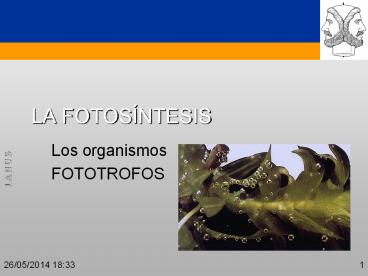LA FOTOS - PowerPoint PPT Presentation
1 / 25
Title:
LA FOTOS
Description:
LA FOTOS NTESIS Los organismos FOTOTROFOS P I G M E N T O S C L O R O F I L A CLOROFILA: Porfirina: dobles enlaces Fitol TIPOS: Clorofila a, principal y – PowerPoint PPT presentation
Number of Views:61
Avg rating:3.0/5.0
Title: LA FOTOS
1
LA FOTOSÍNTESIS
- Los organismos
- FOTOTROFOS
2
P I G M E N T O S
PIGMENTO
CLOROFILA
contiene
contiene
CROMÓFORO
ANILLO DE PORFIRINA
Otros pigmentos xantofila - carotenoides
3
C L O R O F I L A
- CLOROFILA
- Porfirina dobles enlaces
- Fitol
- TIPOS
- Clorofila a, principal y
- Clorofila b algas
- Clorofila c diatomeas, protozoos
4
PIGMENTOS EN GENERAL
5
ESPECTRO DE ABSORCIÓN
6
FOTOSISTEMAS
son
constituyen
300 MOLÉCULAS DE CLOROFILA
UNIDAD FOTOSINTÉTICA
se divide en
Moléculas antena
Centro de reacción
- P700 Fotosistema I
- P680 Fotosistema II
7
F O T O S I S T E M A S
8
FOTOSISTEMAS
- Anclados en las membranas de los tilacoides.
- Ambos son necesarios para la fotosíntesis
9
RELACIÓN DE FOTOSISTEMAS
10
FOTOSÍNTESIS GENERAL
11
FASE LUMINOSA DE LA FOTOSÍNTESIS
- El transporte electrónico
12
TRANSPORTE ACICLICO(esquema en Z)
13
TRANSPORTE ACÍCLICO
14
FOTOFOSFORILACIÓN
15
FOTOFOSFORILACIÓN
16
FOTOFOSFORILACIÓNCÍCLICA
- Sólo interviene el fotosistema I.
- No se reduce el NADP
- No se rompe el H2O no se libera O2.
- Sí se sintetiza ATP.
- Se activa cuando hay desequilibrio entre ATP y
NADPH.
En la fase oscura se consumen 2 ATPs por cada 3
de NADPH.
17
LA FASE OSCURA DE LA FOTOSÍNTESIS
- El proceso de síntesis de compuestos orgánicos
18
LA FASE OSCURA
- Reducción del carbono del CO2 para formar
glucosa.. - Se produce tanto haya luz o no
19
FIJACIÓN DEL CO2
- C3 Ciclo de Calvin
- C4 Ciclo de Hatch Slack
- CAM Metabolismo Ácido Crasuláceo
- ESTUDIAREMOS EN PRIMER LUGAR C3
- Enzima Clave Ribulosa bisfosfato-carboxilasa
- Reacción ribulosa-bisfosfato CO2 da
3-fofoglicerido.
20
ETAPAS 1
- Fijación o carboxilación
- Reducción de PGA a gliceraldeído-3-P(6).
- Consume ATP
- Consume NADPH
- Paso intermedio 1,3-bisfosfoglicérico
- Una de las seis es el producto de la fijación.
- Recuperación o regeneración
21
CICLO SENCILLO
22
DOS VISIONES DE CALVIN
23
BALANCE DE FOTOSÍNTESIS
24
RESUMEN
25
EL PROBLEMA DE LA FOTORRESPIRACIÓN
- RUBISCO dos caminos
- Calvin fotosíntesis
- Fotorrespiración productos inútiles
- C3 carboxilación/oxidación de 31 o 41































